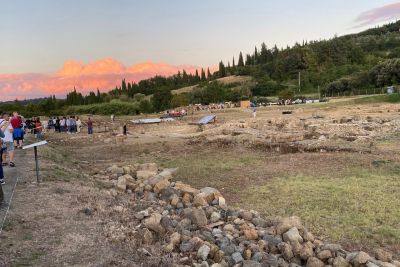I have often termed our bellissima italia “that land of the endless discoveries”. A recent early evening visit to an Etruscan find below Orvieto (of Etruscan origin, 9th century, B.C.) confirmed this.
Spreading out on a volcanic tuff rock plateau, splendid Orvieto overlooks an astounding recent archaeological find: the ruins of perhaps the most vast Etruscan sanctuary (and meeting place of the Etruscan spiritual and political leaders) in central Italy spanning about 2,300 years of history.
Archaeologists estimate that the sanctuary spread out over 100 acres of land below medieval Orvieto, seeming to look out over all like a vigilant sentry. The location of the sanctuary’s site, Fanum Voltumnae (“luogo celeste” or “celestial place”), had been referred to in ancient texts and sought for centuries but discovery was quite recent, as we would learn.
On a summer night, three archaeologists presented the finds to a limited group of people. After parking near a contemporary church below Orvieto, we purchased our tickets and followed others past a farmhouse in a field to the ruins where archeologist Dottoressa Simonetta Stopponi gave us all an introductory presentation of the site.
Etruscan terracotta decorative slabs had first been discovered in 1876 (now in a Berlin museum) in the market area below Orvieto called Campo della Fiera (“Field of the Trade Fairs”), that is, the area where saints’ feast-day fairs (fiere) and cattle markets were once held. On this Etruscan sanctuary site, we would view the foundations of various ancient Etruscan temples (6th century, B.C.) as well as the foundations of a Roman house, a medieval church and a monastery with archaeologists give exciting presentations on the finds.
A plaque near the start of our walk indicated the sites we viewed while labeled photos near the sites illustrated the Etruscan temple foundations. Other photos near the excavation showed a few of the treasures found during excavation.
The site also included the area of a Roman domus (house) of about the 4th century A.D. where an archeologist recounted its history, standing near remnants of the marble floor with a mosaic floor nearby. Here, at the site of the domus, I met Nicola, an archaeology student at the Universita’ di Foggia who was concluding weeks of work at the excavation of Fanum Voltumnae. I asked him about this work in the excavations in the extreme heat and he replied with a wide beam, “the excitement in the work overcame the heat.” Nicola had found various medieval terracotta pitchers, perhaps from the 13th to 14th century, when he was lowered by a harness into an ancient well on the Etruscan sanctuary site.
Just one day prior to our encounter, archaeologists found a pitcher painted with the design of a mermaid. Many water pitchers had been lowered into the Pozzo delle Meraviglie (“Well of the Marvels”) and the chain or rope on the handle had probably broken, the end for over 200 treasures found in the well.
The well had been sealed up at the time of the worst outbreak of the bubonic plague, 1348-1349, as it was considered a source of contamination. Near the well, a table displayed an array of recent finds. One squat pitcher bore the symbol of the crossbow and a taller pitcher behind it, a symbol of the alpha and omega (beginning and end) with the cross of Christ. More than one pitcher bore the family coat-of-arms or another recognizable family symbol. And many pitchers were graced with a symbol in fine relief.
Students from Spain, other areas of Italy, and even a young American woman had united in the steamy excavation labors. All had enthusiasm, knowing they were revealing the wonders of one of the world’s most important Etruscan sanctuary sites.
Nicola’s note to me tells all: “Hi Anne. I can tell you that the experience I had in Orvieto at the Fanum Voltumnae certainly trained me a lot and was useful because it helped me understand even more that the work of an archaeologist is what I want to do in life because only this profession can generate such unique emotions. Working at Fanum Voltumnae, being face-to-face with what you usually read in books, really melts your heart, gives satisfaction, and makes you incredibly happy. Being able to touch it with your hands puts an end to all imagination because you realize that everything is real. It is an incredible joy to witness a discovery, especially when it is you yourself who makes it, just as it is a joy to clear an area, clean a wall with the trowel, use the pickaxe and shovel to remove the ground and discover that all that effort is repaid with a mosaic from the Roman era or even going down a well, not worrying about the dirt and the cold because you know that you will contribute to the discovery of something…you will help to give voice to the past rich in history and [to the voice of] us because the past that we dig is US, inherent in every ceramic fragment, in every mosaic tile, in every stone block of a wall and even in every bone. This life is simply extraordinary and to enclose all the emotions in a few lines would be impossible…”
Mille grazie, Nicola for having shared with me, and the world, the wonders of this celestial place.
https://www.lagazzettaitaliana.com/travel/10309-fanum-voltumnae-an-etruscan-celestial-place-near-orvieto#sigProIda91dd8a758




